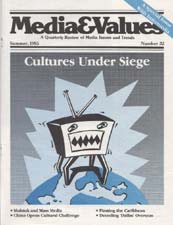Muktuk and Mass Media
|
This article originally appeared in Issue# 32
|
In the Alaskan expanse, communications media are reshaping the lives of the Inuit peoples.
Few experiences penetrate memory as thoroughly as Arctic winds pierce unprotected flesh. In Alaska, images of communication technology reshaping the lives of subsistence Inuit, or Eskimo, peoples can burn and numb like frostbite.
During three years as a Jesuit Volunteer at KNOM-AM, an educationally based, public service radio station in Nome, Alaska, I had frequent opportunity to observe the metamorphosis of Inuit culture, and the role played in that shift by the instruments of mass communication.
On journalistic expeditions to some of the 90 villages served by KNOM's signal I would fly into a world that, from the air, seemed forgotten by time, a few dwellings huddled in a frigid, endless expanse of whiteness, where the primary language is a dialect of Inuit, where polar bear hides dry among whale bones and where walrus-skin boats perched above snowdrifts await the spring hunt as they have for countless generations.
While landing on a bumpy stretch of ice, the primitive scene would inevitably shatter amid the realities of this century. Each scattered outpost sports an enormous satellite dish aimed low to the southern horizon, snow machines noisily bounce out to the plane to retrieve passengers and mail, and the ride to the village reveals evidences of a commercially-oriented, product-dependent society - aluminum boats with massive engines, high-powered rifles, parkas from catalogues, discarded oil drums, beer cans and Twinkie wrappers.
As a non-commercial station KNOM does not encourage product orientation, but its l0,000-watt signal is not the only media presence in western Alaska. Commercial radio has been broadcasting for years, and satellites dish up everything from state-sponsored news to prime time entertainment. By the early l980's some villages were transmitting their own low-power television, and most village high schools have long screened feature films.
This rapid enculturation from tribal hunting society of a few generations ago to the twentieth century world of high technology has produced an anthropologic nightmare. In the same dwelling three generations often coexist with the same heritage, but separated by worlds of different experience and expectation. In an Eskimo's home one can find older generations plying traditional skills of ivory carving, skin sewing, and food preservation (including muktuk, or whale meat) while younger adults jury-rig snow machine engines, and children are absorbed in The Dukes of Hazzard as they devour junk food and sodas.
The elders know that one day their songs will not be sung and the dances explaining an enchanted past will die with them, no matter how many videotapes record them today.
The discontinuity of these images intensifies when one realizes that the loss of traditional subsistence life style and the diminished use of Inuit dialects parallels increased use of modern communication technologies. Cultural shifts accelerated incredibly in the last decade along with the arrival of television, cable, and satellite images that gave a hunting/gathering culture the power and immediacy of the information age.
Nevertheless, to assign a causative role in this cultural transformation to the instruments of mass communication would be an oversimplification.
The Inuit first contacted the "outside" (still a term of reference) through Russian fur traders and American whalers during the last century. These emissaries were from a world of industrial wonder that could make rugged Arctic existence more tolerable. They also left behind new diseases and the seeds of today's plague of alcoholism.
If the world beyond the waters was filled with the materials of convenience, it also contained commercialism and greed. The Gold Rush proved that.
For the most part, the Inuit could maintain their own existence, on their own lands, even after Alaska became part of the U.S. But the challenge of a new frontier brought missionaries, teachers and those who scrape riches off virgin territory.
Then in the early 1970's the federal government granted vast sums of money to Inuit groups as a settlement for "acquisition" of Inuit land a century earlier. In the same decade the Alaskan pipeline bloated state coffers. Dollars fell like snow and these new Americans unknowingly awoke to the American Dream.
That was the process of cultural imperialism. The "outside" provided goodies of industrialization, and the means to acquire them. Television and satellites only framed the picture by delivering seductive images of a product-oriented society.
There is a deep sense of pain and loss among the elders. It shows in their faces, in darkened skin and lines drawn by years of arid coldness. One day soon they know their songs will not be sung, and dances explaining an enchanted past will die along with them, no matter how many video tapes record them today.
Yet, they too are glad for the storm warnings that come by radio, along with messages from relatives in a distant village.
The progression to more efficient communication technologies and the use of more durable goods seems inevitable, but its hectic encroachment into the previously simple lives of Alaska's Inuit population has robbed the Eskimo of generations of social development, dressing the children of whale hunters with the stylized shallowness of a mass mediated generation.



